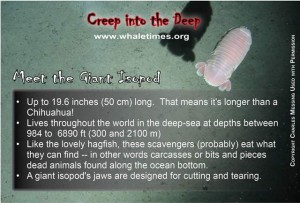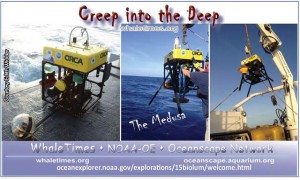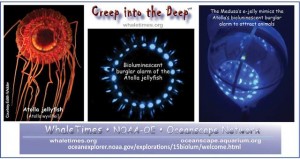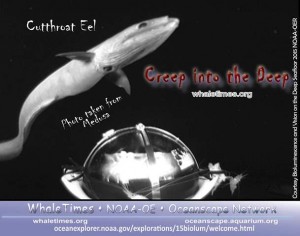A video Postcard from the DEEPEND
A pod of dolphins made a special visit to the DEEPEND Research team to bow ride the R/V Point Sur
Join WhaleTimes at the DEEPEND, no floaties required!
A video Postcard from the DEEPEND
A pod of dolphins made a special visit to the DEEPEND Research team to bow ride the R/V Point Sur
Join WhaleTimes at the DEEPEND, no floaties required!
More fun from Creep into the DEEPEND: MOCNESS Returns
After the MOCNESS returns, the DEEPEND Science Team sorts, identifies and counts the samples. Dr. Tracey Sutton caught the team hopping into action….
Join WhaleTimes at the DEEPEND, no floaties required!
More fun from Creep into the DEEPEND
Watch the DEEPEND Science Team build then deploying MOCNESS in this speedy video!
Join WhaleTimes at the DEEPEND, no floaties required!
Another fantastic deep-sea fish from Team Fish, part of the DEEPEND Research team aboard the R/V Point Sur
Join WhaleTimes at the DEEPEND, no floaties required!
Another beauty from Team Crustacean, part of the DEEPEND Research team aboard the R/V Point Sur.
Read more Postcards from the DEEPEND
Join WhaleTimes at the DEEPEND, no floaties required!
This lobster larva is just one of the many amazing creatures our Science Team will share with kids around the country during our Creep into the DEEPEND Virtual Research Mission September 28 to October 9.
Joins WhaleTimes at the DEEPEND, no floaties required!
Dear Virtual Science Team,
 Though we hoped to see many giant isopods so we could learn more about their vision. So far they have eluded us. Maybe on the next ROV dive or maybe the Medusa secretly videoed them dancing and singing after the ROV left! Wouldn’t that cool?
Though we hoped to see many giant isopods so we could learn more about their vision. So far they have eluded us. Maybe on the next ROV dive or maybe the Medusa secretly videoed them dancing and singing after the ROV left! Wouldn’t that cool?
Tammy
Dr. Tamara Frank
Chief Scientist and Deep-Sea Explorer
Creep into the Deep Mission:
Bioluminescence and Vision on the Deep Seafloor 2015 Expedition, NOAA-OER
Hello Virtual Science Team,
 Today is the fifth day of our cruise and the Medusa is on her second drop. This is the first time for the Medusa to be in the Gulf of Mexico. The Medusa is a camera system designed to explore the deep sea in a new way – one that focuses on attracting animals instead of scaring them away. I became interested in a different way of exploring after many years of diving in submersibles and using Remote Operated Vehicles (ROVs). Both convinced me that animals were avoiding the bright lights and noisy thrusters on these standard exploration platforms.
Today is the fifth day of our cruise and the Medusa is on her second drop. This is the first time for the Medusa to be in the Gulf of Mexico. The Medusa is a camera system designed to explore the deep sea in a new way – one that focuses on attracting animals instead of scaring them away. I became interested in a different way of exploring after many years of diving in submersibles and using Remote Operated Vehicles (ROVs). Both convinced me that animals were avoiding the bright lights and noisy thrusters on these standard exploration platforms.
My solution was a camera platform that was quiet and that could see without being seen by illuminating with red light that is invisible to most deep sea animals and that used an optical lure.  What’s an optical lure? It’s a ring of dim blue lights that imitates the bioluminescent burglar alarm display of a deep-sea jellyfish. The burglar alarm might startle the predator and entice bigger predators to swoop in for a quick meal of the would-be predator. When the e-jelly on the Medusa lights up, it lures animals closer so we can capture them on video.
What’s an optical lure? It’s a ring of dim blue lights that imitates the bioluminescent burglar alarm display of a deep-sea jellyfish. The burglar alarm might startle the predator and entice bigger predators to swoop in for a quick meal of the would-be predator. When the e-jelly on the Medusa lights up, it lures animals closer so we can capture them on video.
It has been remarkably successful and has recorded some amazing things including the first video ever recorded of a giant squid in the deep sea! We probably won’t see any giant squid on this mission but I’m always hopeful that we’ll see something completely new and exciting.
 Here is a photo from its first deployment on this cruise, a very cool eel.
Here is a photo from its first deployment on this cruise, a very cool eel.
It’ll be exciting to find out what else the Medusa saw in the deep!
Cheers,
Edie
Dr. Edith Widder
Marine Biologist and Deep-Sea Explorer
Creep into the Deep Mission:
Bioluminescence and Vision on the Deep Seafloor 2015 Expedition, NOAA-OER